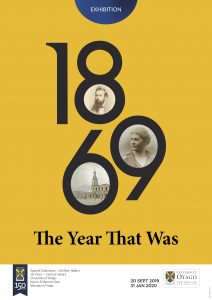 On 3 June 1869, the University of Otago Ordinance 1869 became law. This meant that the newly established University became a corporate body with power to grant degrees. This was a significant first for New Zealand. Two years later, with a building secured (the now demolished ‘Post Office’ building near the Exchange), and three professors appointed: John Shand, (Natural Philosophy); George Sale (Classics); and Duncan Macgregor (Mental and Moral Philosophy and Political Economy), classes began. The first class was on 10 July 1871, with 81 students enrolled. The University of Otago’s rich history continues today. Its establishment and legacy form part of the current exhibition “1869: The Year That Was,” which begins on 20 September 2019 at the de Beer Gallery, Special Collections, 1st floor, Central University Library.
On 3 June 1869, the University of Otago Ordinance 1869 became law. This meant that the newly established University became a corporate body with power to grant degrees. This was a significant first for New Zealand. Two years later, with a building secured (the now demolished ‘Post Office’ building near the Exchange), and three professors appointed: John Shand, (Natural Philosophy); George Sale (Classics); and Duncan Macgregor (Mental and Moral Philosophy and Political Economy), classes began. The first class was on 10 July 1871, with 81 students enrolled. The University of Otago’s rich history continues today. Its establishment and legacy form part of the current exhibition “1869: The Year That Was,” which begins on 20 September 2019 at the de Beer Gallery, Special Collections, 1st floor, Central University Library.
Of course, other events occurred in 1869, forming a then unwritten but much wider history. While the University Council were debating the administrational matters necessary to make the newly formed educational institution work, events were occurring on a local and international level. Each had their own particular impact. Some of the events of 1869 that feature in the exhibition include the formation of the Otago Institute; the first Fine Arts Exhibition in New Zealand; the first ‘Royal’ visit to New Zealand; the introduction of the New Zealand Cross; the births of Rasputin, Emma Goldman, and Gandhi; the opening of the Suez Canal; and the formation of Dmitry Ivanovich Mendeleev’s periodic table. Tolstoy’s War and Peace was published in 1869, as was Louisa May Alcott’s Little Women. ‘Contextualization is everything!’
All these moments and more are available for your viewing pleasure in Special Collections from 9–5 Monday to Friday. Please enjoy “1869, The Year That Was.”

